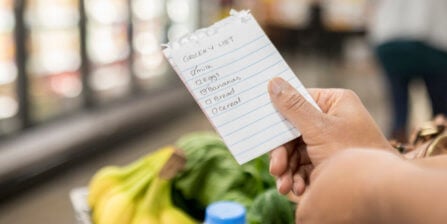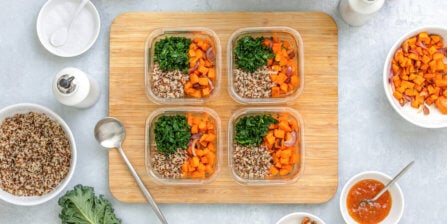Planning & Prep
How to Store Vegetables to Keep Them Fresh

How to store vegetables in the fridge
It’s second nature to put vegetables into the fridge as you unpack your shopping bags, but not all vegetables should go from the bag to the refrigerator. Some can stay out on the counter or in the pantry, while others need to be washed to keep fresh for as long as possible.
Take care to keep your vegetables away from your fruits because commonly bought produce like apples, bananas, and tomatoes are high in ethylene which speeds up ripening. In turn, your vegetables will go bad sooner than if they had been kept apart. Get in the habit of preserving fruits and vegetables in separate drawers in your refrigerator and on opposite ends of your counter.
Storing leafy greens
Leafy vegetables are prone to wilting and going bad within a few days of purchasing them. To ensure that your lettuce, kale, spinach, and bok choi stay fresh and edible until the day that you use it, you should first wash it and let it drain in a colander. Then wrap the greens in paper towels or a tea towel. To ensure they remain salad-worthy, you can store the wrapped greens in a container in the fridge for up to a week.
Storing non-root vegetables
Most non-root vegetables, those that grow above ground, like bell peppers, celery, green beans, beets, and Brussels sprouts, can be stored in the crisper drawer of your refrigerator. It’s best to leave the vegetables unwashed and in the plastic packaging until you’re ready to prepare them.

Some vegetables emit higher levels of ethylene, and you should keep them separate so that they don’t cause other veggies to go bad prematurely. These vegetables include green onions, peas, broccoli, corn, carrots, cauliflower, and radishes. They should be stored unwashed and in plastic bags in the crisper drawer. To extend their shelf life, keep the produce drawer’s air vent closed so that the area remains humid.
Fresh mushrooms and okra should be stored, unwashed, in paper bags so that air can circulate and they don’t become slimy.
How to store vegetables in the pantry or on the counter
Some vegetables don’t require refrigeration until they are cut open. An onion can sit out in a basket on your counter until you use it for fajitas. The remaining half should be covered and refrigerated, as should and leftover cooked fajita vegetables.
Root vegetables like onions, potatoes, squash, garlic, yams, sweet potatoes, and pumpkins are best stored in a cool, dark place like a pantry, root cellar, or basement. When stored properly, these vegetables can last for one to two months.
Tomatoes, while technically a fruit, taste best and last longer when stored at room temperature. You can keep them out on your counter until you’re ready to use them. The same holds for avocados. You should ripen them at room temperature but store them in the fridge to prevent them from becoming overripe.

How to store vegetables long term
For those times when your neighbor drops off ten pounds of zucchini or the grocery store has 30-pound bags of onions at a fantastic price, it’s essential to know how to store them long term to avoid food waste. Once you know you’re not going to be able to eat vegetables fresh, you need to decide how you’ll preserve them. Here’s a look at the three main options: freezing, canning, and dehydrating.
Freezing vegetables
For those times when you get a great sale on tomatoes, your partner and you both end up buying bags of avocados, or you can’t pass up sweet corn that’s 30 for $10, it’s good to know that there are options.
Most vegetables can be frozen. Freezing is faster and more accessible, and you don’t need any special tools. For some foods like carrots, corn, peas, broccoli, green beans, and peppers, you can wash, cut, and blanch the veggies before placing them on parchment paper-lined baking sheets to freeze. After two or three hours, the pieces are frozen solid, and you can transfer them to freezer bags or containers. Don’t forget to label them with the contents and date!
Some foods, like tomato and onions, can be frozen without blanching but are not visually appetizing after being frozen. You can, however, put them in soups, stews, pasta sauce, and casseroles with no effect on the flavor, and no one will be the wiser.
Another way to use up vegetables is to cook them into a sauce or sautee them before freezing. You can use extra tomatoes, onion, and garlic for a pasta sauce. Carrots, onions, and green beans can be cooked and frozen together for a chicken soup.
Canning vegetables
People still use this method to keep vegetables and fruits to enjoy throughout the winter. Canning isn’t difficult, but it does take some time to prepare and process the jars of food. It’s a great way to take advantage of large purchases of tomatoes, squash, corn, carrots, pumpkin, and green beans.
Drying vegetables
Using a dehydrator or just going the old-fashioned route and putting the vegetables outside to dry is another option for storing vegetables long term. You can dry herbs, onions, carrots, potatoes, and mushrooms for use in soups and casseroles. Garlic and onion can be dried and then blended to create garlic powder and onion powder. For optimal preservation, dried vegetables need to be stored in dark, dry areas.
Have a plan for extra veggies
Knowing how to store vegetables properly and save them for later by preserving them is key to keeping your budget and food waste low. Soups, salads, stir-frys, and casseroles are great ways to transform basic veggies into a delicious dinner. It’s also good to have a few go-to recipes that will use up large amounts of vegetables when you find yourself with some wilting produce.
Most Recent in Planning & Prep

Planning & Prep
Guide to Food Delivery for New Parents
Welcoming a new baby into the family is an incredible joy, but it often comes with its own set of challenges, especially when it comes to meal preparation. Juggling sleep deprivation, endless diaper changes and…...
Nov 21, 2024
Planning & Prep
Baby Food Delivery: A Convenient Solution for Parents
As a busy parent — especially a first-time parent — finding time to shop for essentials can feel overwhelming. That’s where baby food delivery becomes a lifesaver. Instead of making frequent trips to the store,…...
Nov 21, 2024
Planning & Prep
Theme Park Pharmacy Delivery: A Guide to Vacation Pharmacies
Imagine this: You're strolling through the magical world of theme parks, surrounded by the sights, sounds and excitement. Suddenly, you realize you've forgotten your essential medication. Instead of cutting your vacation short to find a…...
Oct 24, 2024

 17 Grocery List Categories to Make Shopping Easy
17 Grocery List Categories to Make Shopping Easy  How to Meal Plan: Step-by-Step Guide to Meal Planning
How to Meal Plan: Step-by-Step Guide to Meal Planning  How To Read Food Labels: Guide to Nutrition Labels
How To Read Food Labels: Guide to Nutrition Labels 

